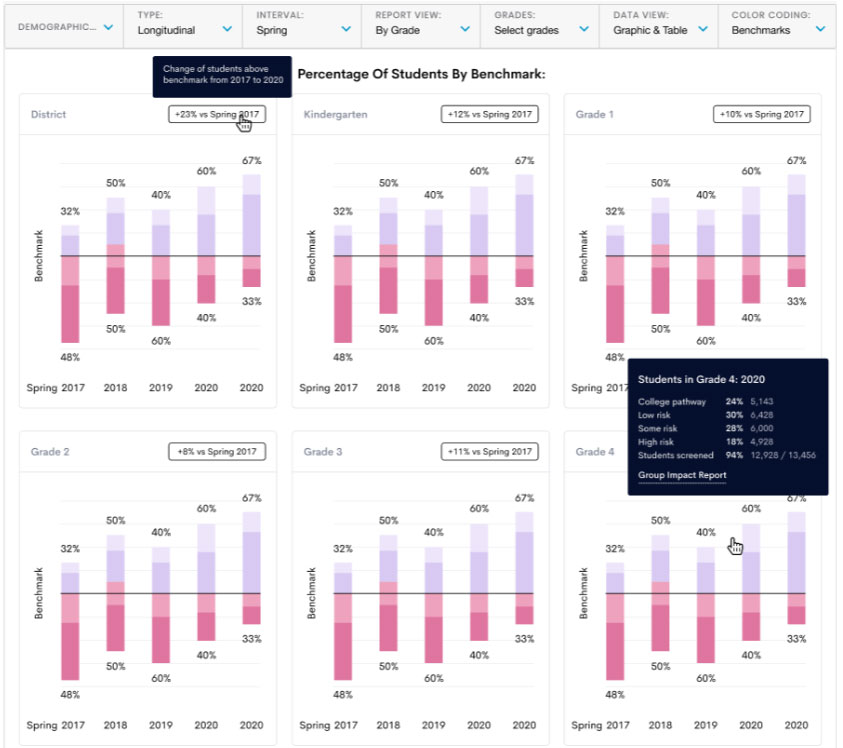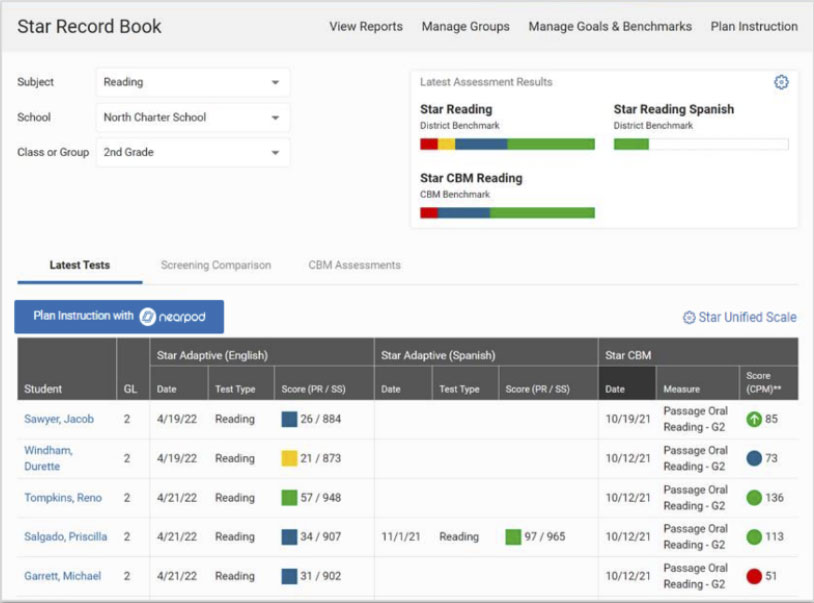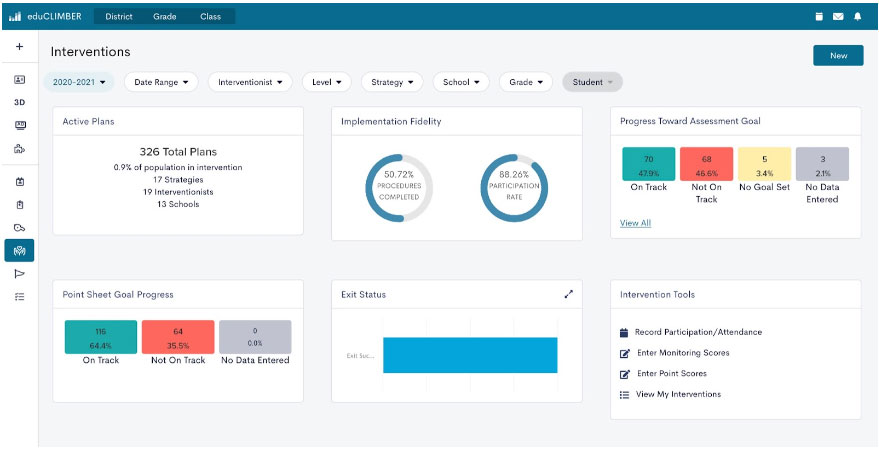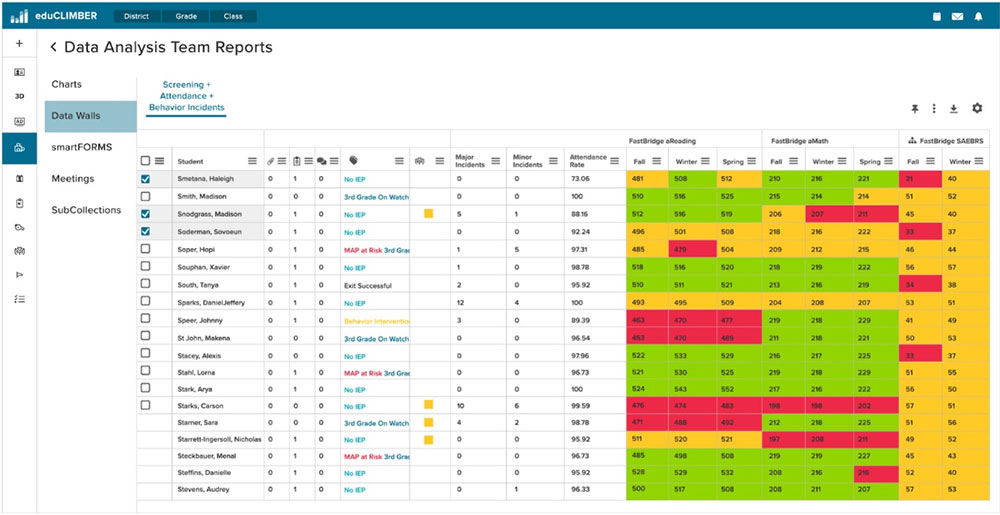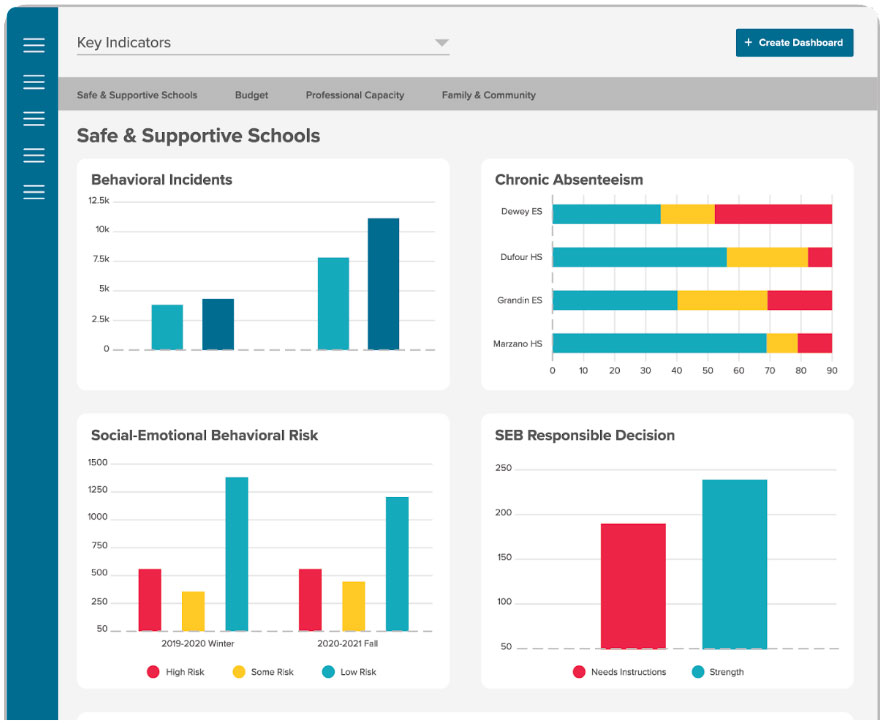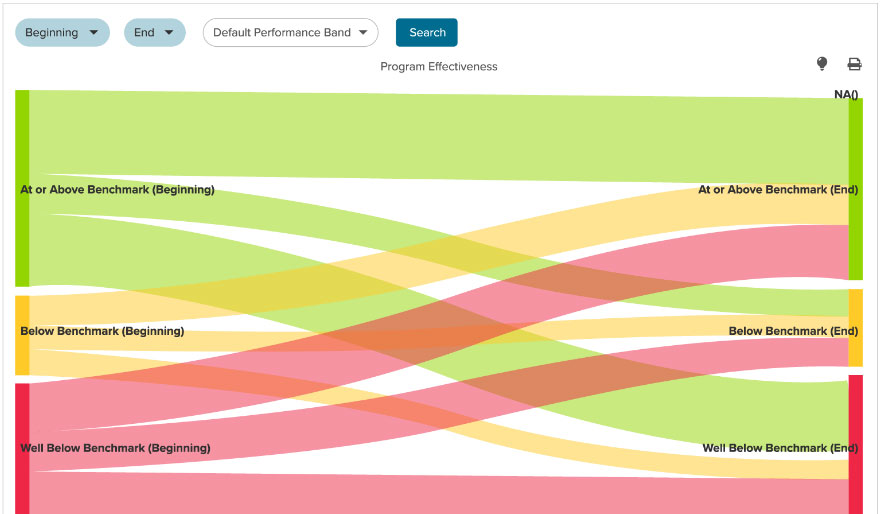Tiers in an MTSS framework:
To effectively implement an MTSS, districts need to be able to access and utilize whole child data at the right time–and from a single location–to drive decision making. Educators also need smart workflow tools to help them efficiently and collaboratively move through their MTSS and RTI processes so they spend more time supporting students and less time on logistics.
Supercharge your MTSS with Renaissance
Renaissance offers the most comprehensive approach to implementing a data-driven, equity-based MTSS.
Integrating our assessments, practice products, and our MTSS collaboration and management platform provides you with a central hub and built-in tools for key MTSS and RTI practices, such as whole child need identification, purposeful practice, intervention tracking, team collaboration, and more.
As a result, your team can use assessments, practice products, and whole child insights to pinpoint academic and SEB needs, align targeted instruction and intervention, monitor progress, and evaluate what’s working at each tier.
Want to know more?
Learn more below, or reach out today to talk to an expert.
Screen all students
Identify which students are at risk for academics and SEB.
- Identify risk levels with our universal screeners across math, reading, and SEB
- Establish a district-wide infrastructure to efficiently meet students’ holistic needs.
Learn more about our universal screeners, including Star and FastBridge.
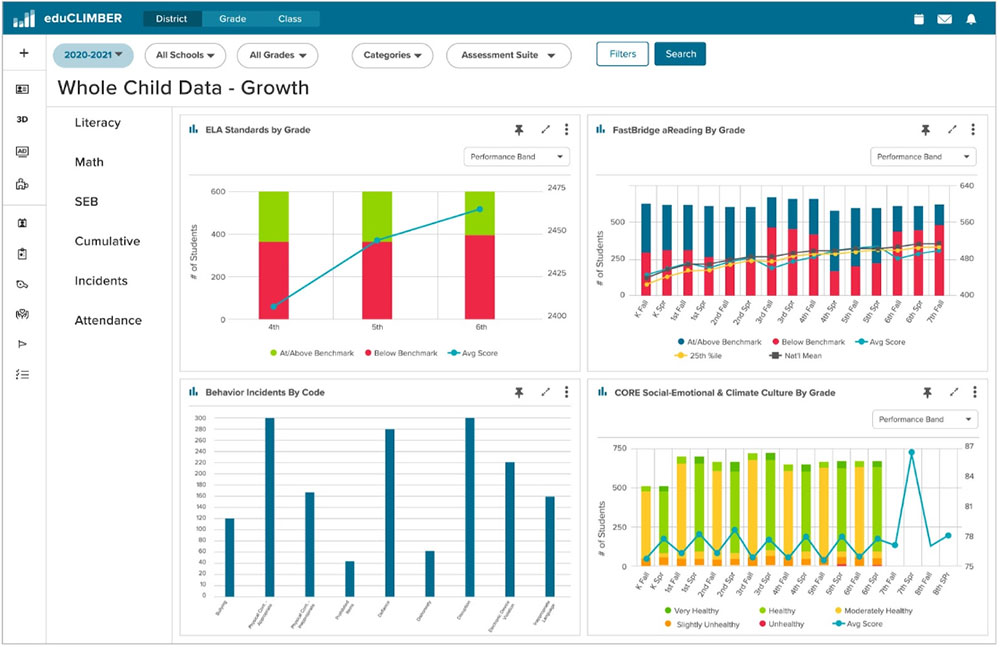
Strengthen tier 1
Drive system-level resources and plan Tier 1 intensifications to bolster growth for all students and address universal whole child needs.
- See whole child data–including academics, SEB, attendance, incidents, interventions, and other data–in one place
- Use interactive reports to explore patterns across years at student, group, grade, school, and district levels
- Drive decisions around curriculum, programming, staffing, and professional development to meet areas of Tier 1 need
- Use early warning systems across academics, behavior, and attendance to drive proactive prevention and intervention
Learn more about eduCLIMBER.
Align tier 2 and tier 3 interventions
Identify students for intervention and match whole child supports to their needs.
- Group and monitor students with similar needs
- Utilize student profile data to individualize interventions
- Easily create, assign, and manage student interventions
- Monitor intervention fidelity (duration, attendance, and engagement) with built-in tools
Learn more about eduCLIMBER.
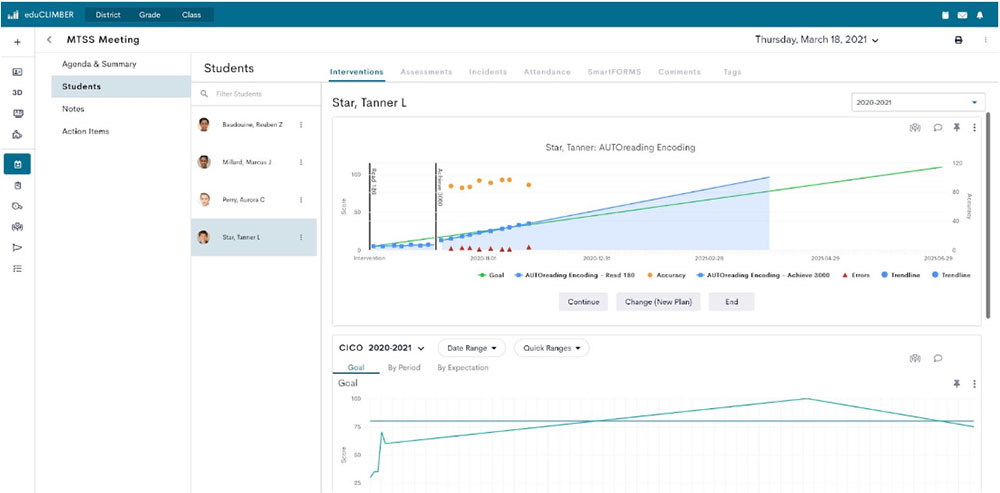
Progress monitoring
Collect frequent data to determine whether interventions are working and if students are on track to meet their goals.
- Measure intervention effectiveness with our research-based, valid, and reliable progress monitoring tools
Learn more about our Progress Monitoring.
Evaluate effectiveness and equity
Know what’s working at every tier to celebrate successes and drive timely adjustments where needed
- Evaluate the impact of Tier 1 intensifications with interactive effectiveness reports
- Disaggregate results by different groups of students (e.g., ethnicity, gender, disability code) to monitor for equitable growth
- Review intervention and progress monitoring data as a team to determine whether to continue, fade, or adjust group and individual interventions
- Determine the effectiveness of each intervention strategy and your overall program with intervention analytics
- Gain a holistic view into what’s happening across the district in the moment to monitor progress toward strategic goals and communicate successes to stakeholders with interactive dashboards
Learn more about eduCLIMBER.
Ready to learn more?
Reach out to talk to an expert.
How Renaissance can help
Renaissance products for this solution
Accurate assessment
| PK | K | 1 | 2 | 3 | 4 | 5 | 6 | 7 | 8–12 |
|---|
| FastBridge | K–12 |
|---|---|
| myIGDIs | PK |
| Star Assessments | PK–12 |
| Star Phonics | PK–2 |
Actionable insights
| PK | K | 1 | 2 | 3 | 4 | 5 | 6 | 7 | 8–12 |
|---|
| eduCLIMBER | PK–12 |
|---|
MTSS FAQs
Learn more about how an MTSS helps educators take a data-driven approach to meeting each student’s whole child needs.
Many districts and states use the terminology “multi-tiered system of support (MTSS)” and “Response to Intervention (RTI)” synonymously. Both refer to using data to support the needs of all students. Over time, MTSS has become the preferred term in many places because it expands beyond academics to include whole child data, including SEB. The foundational components and intended outcomes are often similar between the two.
A comprehensive assessment system is a foundational component of an MTSS. Key assessments include universal screening and progress monitoring, which help educators and leaders maximize supports across every tier to meet each student’s needs. For students needing more intensive and individualized support, having access to assessments that diagnose specific skill and instructional needs is critical to student success. High-quality standards-based assessments, such as those in DnA, are an essential component of a strong Tier 1 as they fuel ongoing formative assessment practices and continually inform standards-based instruction throughout the year.
Support throughout the tiers of an MTSS occurs through data-based resource allocation and varies based on each school’s context and resources. At Tier 1, universal screening data may suggest that a Tier 1 intervention is in order. In that case, an instructional coach may help a grade level team to choose and learn a classwide intervention. At Tier 2, grade-level teams may use universal screening data to assign all students to grade-level instructional groups for supplemental intervention, so one intervention is provided during the common intervention time. At Tier 3, intensive, individualized interventions may be provided by a specialist during student independent work time.
Tier 1 resources include those resources that are provided for all students within a school. This includes:
- Comprehensive assessment system, including universal screening and formative assessment practices
- Research-based universal curriculum, instruction, and whole-group intensification
- Team data-based decision making; early warning systems
- Educator professional learning
- Student, family, and community engagement
- Supportive school climate and culture
- Intentional infrastructure to support effective practice
An effective Tier 1 results in about 80% of students in a grade level being on track to meet grade-level standards without additional intervention. This allows supplemental and intensive resources to be robust enough to provide adequate support to those students who need them to meet grade-level standards.
In schools where there are not yet 80% of students meeting expectations, Tier 1 supports should be intensified and improved to meet students’ needs. This may include reviewing instructional strategies and materials used, providing whole group interventions to all students in a grade level to teach targeted skills, and considering how resources such as instructional coaches and literacy experts can be used in a strategic manner.
Positive Behavior Interventions and Supports (PBIS) is an SEB tiered supports framework that aligns wholly with an MTSS framework. Many districts implement PBIS practices as part of their MTSS implementation.
The MTSS framework is designed to adapt, respond to, and meet the needs of secondary learners and their settings. While the goals and principles remain the same, some of the activities vary to meet the specific context of secondary settings and learners, according to what they need to be successful. Because secondary learners often have more complex needs and secondary educators serve many more students, the structure and support that an MTSS framework provides can be even more necessary at the secondary level.
The MTSS framework is designed to help schools best allocate resources to ensure all students succeed, including students with disabilities. Several supports within an MTSS have cascading effects that can make special educators’ roles more efficient. For instance, when valid and reliable progress monitoring tools are available throughout the school, special educators can use those same tools for their students with disabilities.
As another example, regular team meetings in which educators use data to drive planning also support special educators as they determine how to improve instructional programs for the students they serve.
States have developed local initiatives to support MTSS implementation given local context and resources. Yet, the foundational principles and practices found within an MTSS framework are consistent across states.


